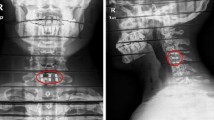Abstract
This study was conducted to estimate thyroid dose and the associated risk for thyroid cancer induction from common head and neck computed tomography (CT) examinations during childhood. The Monte Carlo N-particle transport code was employed to simulate the routine CT scanning of the brain, paranasal sinuses, inner ear and neck performed on sequential and/or spiral modes. The mean thyroid dose was calculated using mathematical phantoms representing a newborn infant and children of 1year, 5 years, 10 years and 15 years old. To verify Monte Carlo results, dose measurements were carried out on physical anthropomorphic phantoms using thermoluminescent dosemeters (TLDs). The scattered dose to thyroid from head CT examinations varied from 0.6 mGy to 8.7 mGy depending upon the scanned region, the pediatric patient’s age and the acquisition mode used. Primary irradiation of the thyroid gland during CT of the neck resulted in an absorbed dose range of 15.2–52.0 mGy. The mean difference between Monte Carlo calculations and TLD measurements was 11.8%. Thyroid exposure to scattered radiation from head CT scanning is associated with a low but not negligible risk of cancer induction of 4–65 per million patients. Neck CT can result in an increased risk for development of thyroid malignancies up to 390 per million patients.




Similar content being viewed by others
References
International Commission on Radiological Protection (2000) Managing patient dose in computed tomography. ICRP publication 87. Pergamon Press, Oxford
Mettler FA, Wiest PW, Locken JA, Kelsey CA (2000) CT scanning: patterns of use and dose. J Radiol Prot 20:353–359
International Commission on Radiological Protection (1990) Recommendations of the International Commission on Radiological Protection. ICRP publication 60. Pergamon Press, Oxford
Hall EJ (2000) Radiobiology for the radiologist, 5th edn. Lippincott Williams & Wilkins, Philadelphia
Fearon T, Vunich J (1987) Normalized pediatric organ-absorbed doses from CT examinations. AJR Am J Roentgenol 148:171–174
Zankl M, Panzer W, Petousi-Henb N, Drexler G (1995) Organ doses for children from computed tomographic examinations. Radiat Prot Dosimetry 57:393–396
Brenner DJ, Elliston CD, Hall EJ, Berdon WE (2001) Estimated risks of radiation-induced fatal cancer from pediatric CT. AJR Am J Roentgenol 176:289–296
Tzedakis A, Damilakis J, Perisinakis K, Stratakis J, Gourtsoyiannis N (2005) The effect of z overscanning on patient effective dose from multidetector helical computed tomography examinations. Med Phys 32:1621–1629
Boone JM, Seibert JA (1997) An accurate method for computer-generating tungsten anode X-ray spectra from 30 to 140 kV. Med Phys 24:1661–1670
Eckerman KF, Cristy M, Ryman JC (1996) The ORNL mathematical phantom series. Oak Ridge National Laboratory, Oak Ridge, Tenn
Siemens (2002) SOMATOM Sensation 16 application guide: routine protocols. Siemens, Forchheim
National Council on Radiation Protection and Measurements (1985) Induction of thyroid cancer by ionizing radiation. NCRP report 80. NCRP Publications: Bethesda, Maryland
Hohl C, Muhlenbruch G, Wildberger JE, Leidecker C, Suss C, Schmidt T, Gunther RW, Mahnken AH (2006) Estimation of radiation exposure in low-dose multislice computed tomography of the heart and comparison with a calculation program. Eur Radiol 16:1841–1846
Theocharopoulos N, Perisinakis K, Damilakis J, Karampekios S, Gourtsoyiannis N (2006) Dosimetric characteristics of a 16-slice computed tomography scanner. Eur Radiol Apr 22; [Epub ahead of print] DOI http://dx.doi.org/10.1007/s00330-006-0251-0
Vock P (2005) CT dose reduction in children. Eur Radiol 15:2333–2340
Bacher K, Bogaert E, Lapere R, De Wolf D, Thierens H (2005) Patient-specific dose and radiation risk estimation in pediatric cardiac catheterization. Circulation 111:83–89
Mazonakis M, Damilakis J, Raissaki M, Gourtsoyiannis N (2004) Radiation dose and cancer risk to children undergoing skull radiography. Pediatr Radiol 34:624–629
Perisinakis K, Raissaki M, Damilakis J, Stratakis J, Neratzoulakis J, Gourtsoyiannis N (2006) Fluoroscopy-controlled voiding cystourethrography in infants and children: are the radiation risks trivial? Eur Radiol 16:846–851
Author information
Authors and Affiliations
Corresponding author
Rights and permissions
About this article
Cite this article
Mazonakis, M., Tzedakis, A., Damilakis, J. et al. Thyroid dose from common head and neck CT examinations in children: is there an excess risk for thyroid cancer induction?. Eur Radiol 17, 1352–1357 (2007). https://doi.org/10.1007/s00330-006-0417-9
Received:
Revised:
Accepted:
Published:
Issue Date:
DOI: https://doi.org/10.1007/s00330-006-0417-9




